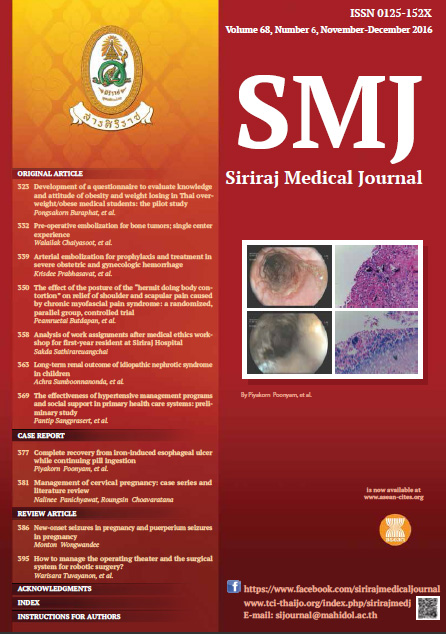The Effect of the Posture of the “Hermit Doing Body Contortion” on Relief of Shoulder and Scapular Pain Caused by Chronic Myofascial Pain Syndrome: A Randomized, Parallel Group, Controlled Trial
Keywords:
Hermit doing body contortion, court-type Thai traditional massage, myofascial pain syndrome, scapula, shoulderAbstract
Objective: To explore the ability of the posture of the “Hermit Doing Body Contortion” (HDBC) to relieve shoulder and scapular pain in patients with chronic myofascial pain syndrome (MPS).
Methods: One hundred and thirty-six out-patients with chronic MPS were randomly assigned to one of two groups. The experimental group was advised to perform a posture of the HDBC named “posture for relieving abdominal pain, pain of the scapular blade” (PRASP) every day for two months. Both groups received Thai traditional massage treatment and hot herbal compresses once a week for four weeks. Using a numeric rating scale and dolorimeter, outcomes were assessed prior to commencing the intervention (M0), and one and two months after commencing the intervention (M1 and M2,).
Results: The mean change in pain intensity between M1 and M2 differed significantly between the groups (1.32±1.45 in the experimental group and 0.47±2.26 in the control group; p = 0.039). Similarly, the mean change in pressure pain threshold between M0 and M2 also differed significantly between the groups (1.39±1.76 in the experimental group and 0.53±1.90 in the control group; p-value =0.027). In both cases, the experimental group achieved greater pain relief.
Conclusion: In patients with chronic MPS, the posture of the HDBC combined with standard Thai traditional medicine treatments provided better ongoing relief of shoulder and scapular pain than did standard Thai traditional medicine treatments alone.
Clinical trial registration no.: TCTR20151230002
Downloads
Published
How to Cite
Issue
Section
License
Authors who publish with this journal agree to the following conditions:
Copyright Transfer
In submitting a manuscript, the authors acknowledge that the work will become the copyrighted property of Siriraj Medical Journal upon publication.
License
Articles are licensed under a Creative Commons Attribution-NonCommercial-NoDerivatives 4.0 International License (CC BY-NC-ND 4.0). This license allows for the sharing of the work for non-commercial purposes with proper attribution to the authors and the journal. However, it does not permit modifications or the creation of derivative works.
Sharing and Access
Authors are encouraged to share their article on their personal or institutional websites and through other non-commercial platforms. Doing so can increase readership and citations.











